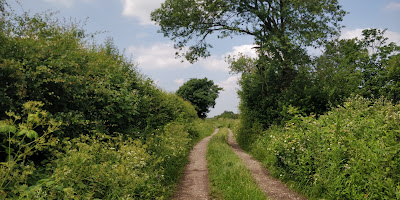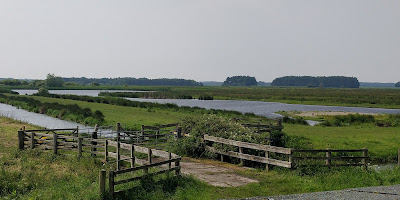 |
| Shelduckling |
Third time lucky, and despite the trains to and from Southport being particularly prone to strikes, I got to Martin Mere.
I got off the train at New Lane and walked along the track beside the railway. Spadgers, robins and blackbirds rummaged around in the hedgerows, more blackbirds and robins sang with the chaffinches and whitethroats and I was struck by the absence of both midges and hirundines, both probably put off by the cold edge to the wind on a cloudy day. I very rarely hear or see yellowhammers round here so it was good to hear two or three of them singing from the hedgerows on the other sides of the fields.
 |
| Juvenile starlings, New Lane You hum it, I'll play it. |
The vast majority of the starlings on the water treatment works were juveniles. I had the impression that the adults had dumped them there at breakfast club while they went to have a rest. There were a few magpies and black-headed gulls on there, a couple of pied wagtails flitted about and a pair of oystercatchers felt the need to chase any carrion crows away from a corner of the compound.
 |
| Stonechat, New Lane |
As I was walking along the margin of the field of fennel I was kept under close escort by a male stonechat. The fact he was on his own suggested his mate was busy at the nest. (The pair that's usually lurking around the collapsed shed on the other side of the railway didn't make an appearance at all, which is very unusual.)
 |
| Walking by the line |
Whitethroats, chiffchaffs and willow warblers sang from the trees on the opposite side of the line. As did a Cetti's warbler which came as a surprise. By the end of the day I'd have heard more Cetti's warblers singing from hedgerows than chiffchaffs or blackcaps.
Overhead pairs of stock doves flew to and fro, there was a steady traffic of woodpigeons and jackdaws and a couple of jackdaws closely shadowed a kestrel on its way across the fields. Way over by the copse beside the road a couple of carrion crows were giving a buzzard a hard time.
 |
| The path around Martin Mere |
I crossed the line, walked round the field. Reed buntings and yellowhammers sang in the rough between the field and the reserve. The surprise of the day was two kingfishers flying across the path right in front of me and heading off for the distant reedbeds. I watched them on their way and joined the path that runs round the outside of Martin Mere. One of the unexpected outcomes of the lockdown period is that this walk's pretty much become routine for me. Cetti's warblers, chiffchaffs, willow warblers and blackbirds sang in the hedgerows, sometimes accompanied by robins or wrens, others by song thrushes or chaffinches, and every so often by a pheasant. Behind the hedge in the reedbeds beyond reed warblers, reed buntings and sedge warblers sang, coots quarrelled and greylags muttered to keep their goslings in line. At a couple of points I could see some of the pools beside the reedbed hides, avocets and lapwings wading in the shallows or chasing off passing crows and gulls.
 |
| Early purple orchid |
There were orchids amidst the buttercups and yellow rattle in the small stretches of meadow. The common spotted orchids (and/or hybrids including common spotted orchid, they're a bit promiscuous) had background colours ranging from pure white to dark wine red almost matching the colours of the spikes of the early purple orchids deeper in the grass. There were enough insects on the meadows for swallows to hawk around at knee height, swooping round to avoid me only at the very last second.
The sun started to poke through the clouds and woke up the damselflies and dragonflies. Common blue damselflies were abundant by the path margins, with enough azure damselflies in the mix to stop me getting cocky and plenty of freshly emerged immature damsels still in ghostly colours that I didn't have a hope of identifying. My first banded demoiselle of the year, a dramatic-looking gun metal blue male with mostly black wings, flitted past into the reedbeds.
 |
| Silver Y moth |
The sun eventually woke up the butterflies and day-flying moths. The butterflies were nearly all large whites and speckled woods, a couple of large skippers were keeping undercover in the grass. For a moment I almost convinced myself that a silver Y moth was a skipper of some kind.
 |
| Shelducks I don't recall seeing that sky pointing posture before |
 |
| The same shelducks in more conventional pose |
I left the reedbed margins and joined the path to the road, treading in the only patch of mud of the day just because. A tractor was working in the field though I couldn't work out what work was being done. Despite this there were a couple of dozen shelducks with the mallards, crows and jackdaws, perhaps taking a breather from half-term fun.
 |
| Black-headed gulls, nests and chicks |
 |
| Black-headed gulls and greylags |
I went straight to the Discovery Hide for a look at the mere. It felt fairly quiet despite the couple of hundred black-headed gulls out there. Some were sitting on eggs, some had tiny chicks and some juveniles were testing their wings for take-off, reflecting the long, protracted entry into Spring. Greylags and Canada geese bobbed about in gangs, mallards and tufted ducks in pairs, shelducks in ones and two and usually looking round to see where their ducklings had hared off to (reckless isn't the word). A couple of common terns flew about but never quite settled. It took me ages to find the Mediterranean gull dozing on a distant island.
 |
| Preening shelduck |
A marsh harrier floated over the distant fields, its passage marked by mobbing lapwings and black-headed gulls.
I wandered down to what used to be called the Kingfisher Hide (for the life of me I can't remember its new name). The tree-lined paths were fairly quiet, a few woodpigeons and great tits, not a sign — again — of any tree sparrows. I turned onto the side path to the hide and was astonished to hear a female tawny owl hoot. I know they're around here and every time I pass by I search the trees for a roosting owl but I can't remember ever hearing a tawny owl in broad daylight before. I couldn't think what might provoke the call then two carrion crows sidled out of the trees next to me and flew off. Try as I might I couldn't actually see the owl.
 |
| The view from the Kingfisher Hide |
It was deadly quiet at the Kingfisher Hide. I was grateful when a blackbird flew by.
 |
| From the Ron Barker Hide |
It wasn't a lot busier at the Ron Barker Hide. A few mallards and tufted ducks rummaged about in the drain with a mute swan. A few black-headed gulls and coots dozed and squabbled on the pools. Canada geese and goslings grazed.
On the way back I spent a good quarter of an hour scouring the trees for any signs of tawny owls. With no luck. It ought to be easy finding something the size and shape of a Watney's Red Barrel, perhaps I'm just not very good at seeing owls.
 |
| Red Cat Lane, Burscough |
I checked the train times. There was no point in walking round for the next train from New Lane as it was cancelled and by the looks of it the next one a couple of hours later was, too. I walked down to Burscough Bridge, the fields looking and sounding deceptively quiet. Every so often some woodpigeons or goldfinches would emerge or pairs of stock doves fly by in a purposeful manner. Swallows and house martins hawked over turf fields that were being mown. A flock of black-headed gulls, jackdaws and rooks followed a plough while lapwings kept their distance. And as I walked down the road into Burscough I could see fifty or more woodpigeons lurking in a field of potatoes.
I got the next train home from Burscough Bridge, was just late enough back into Manchester to get the train home but never mind, it had been a good day out.


No comments:
Post a Comment